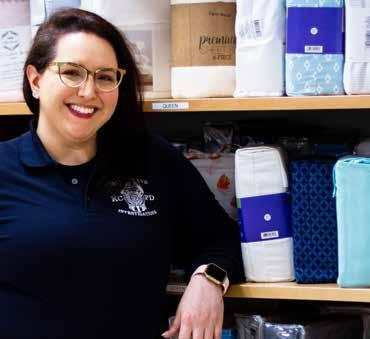FOR ALUMNI
CAREER CENTER From Idea to Reality: Meet the Inventor of Shark OFF
F
or some, the thought of swimming in open ocean water is a dream come true. For others, especially those unfamiliar with the ocean, like Shea Geist ’10, ’11 MBA, it sounded terrifying. That is why she and her husband, Geoff, invented Shark OFF shark repellent jewelry. The idea was born when the couple was watching a PBS documentary called “How to Repel a Shark Attack: Hunting the Elements.” “They were interviewing one of the scientists who discovered the technology we use in Shark OFF,” said Geist. “We couldn’t understand why this idea wasn’t being sold in every beach shop as a consumer product. At that point, it was only used in research to reduce shark bycatch in commercial fishing.” Geist instantly had a connection to the technology. “We had recently returned from Kauai where it took me two days to find the courage to swim in an enclosed ocean area,” she said. “I want to teach my son to be strong and brave – maybe some kind of repellent would put my mind at ease?” The couple filed their idea away until going through the Kauffman FastTrac program. “That was it,” she said. “Everyone was interested. We set up our LLC right after that.” From there came years of research and product development, including testing five different alloys with the Bimini Biological Field Station Foundation in the Bahamas. “The first four did not work,” said Geist. “We had little hope in the fifth one because it had slightly less voltage, but sure enough it worked.”
Shea,’10, ’11 MBA, Max and Geoff Geist
“Sharks can actually sense five one-billionths of a volt,” she said. “We put the alloy into a seven-shark feeding frenzy in open water and, sure enough, every single shark did a 180-degree turn away from the bait. It’s a moment we’ll never forget.” Geist attributes some of her success to her RU education. “I absolutely feel like that played a role in this. The finance, business analysis and accounting classes definitely gave me a leg-up. The commitment to service also guides our business practices. We want to use this opportunity to make the world a better place. We’re saving sharks, one human at a time. ” In addition to helping fearful ocean goers, the Geists’ invention also aids sustainability efforts, with 10 percent of proceeds going to the Ocean Voyage Institute, which redirects existing commercial fishing resources to clean up the Great Pacific Garbage Patch.
Voltage? Yes. The alloy in Shark OFF bracelets creates about 1.5-volts in a one-meter-wide electrical field – a voltage humans cannot sense but sharks can.
“We couldn’t understand why this idea wasn’t being sold in every beach shop as a consumer product. At that point, it was only used in research to reduce shark bycatch in commercial fishing.” —Shea Geist ’10, ’11 MBA ROCKHURST.EDU
29








